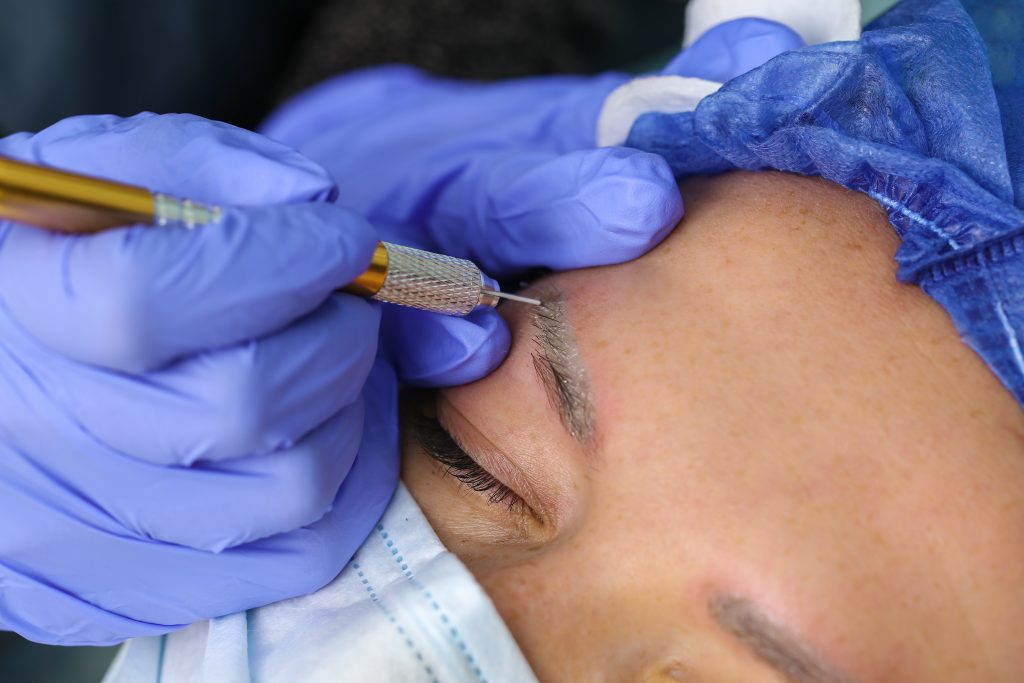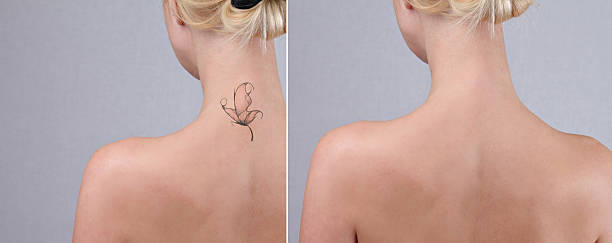Alkaline and acid tattoo removal are two distinct methods for removing tattoos using chemical agents that work to break down the pigment particles in the skin. Both techniques involve introducing substances to the skin that alter the tattoo ink’s structure so it can be eliminated by the body’s immune system. These methods are often considered alternatives to laser tattoo removal.

Alkaline tattoo removal uses a high-pH (alkaline) solution to break down the pigment of the tattoo. The solution is typically made of a mixture of alkaline chemicals, such as sodium hydroxide, that when applied to the skin, help to dissolve the ink.
The alkaline solution is applied to the tattooed area, where it reacts with the tattoo pigment. The alkaline solution essentially “lifts” the ink out of the skin by breaking it down into smaller particles that the body can more easily remove. This process also causes the skin to peel and form a scab as part of the healing process.

Acid tattoo removal uses an acidic solution, typically containing a form of glycolic acid or trichloroacetic acid (TCA), to break down the tattoo ink. These acids work by chemically exfoliating the skin and penetrating the layers where the ink is deposited.
Similar to alkaline removal, the acid solution is applied to the skin, where it causes a controlled chemical reaction. The acid works to break up the ink particles, which then start to fade as the skin heals. The body’s immune system gradually flushes the pigment from the skin over time. The process may involve multiple applications and some aftercare to prevent scarring or infection.
Preparing for your appointment is just as important for good healed results as post care. Failure to follow pre-care may result in you being sent home the day of your appointment, so please read the following carefully! Coming prepared to your appointment means better healed results and a better overall experience.
Two Weeks Before
BOTOX: If you regularly get Botox or Dysport, it must be done at least 14 days prior to your appointment. It takes at least that long to settle in the skin. Receiving it withing 14 days of your appointment will result in being sent home and asked to reschedule.
Waxing/Threading: I recommend coming to your appointment with your brows grown out, no need to have them cleaned up before! I prefer to see how they grow naturally, and will clean them up for you at your appointment. If you need to clean them up beforehand, please do so at least 2 weeks before your appointment. If you tint your brows, please do so at least 7 days prior.
Retin-A: Please refrain from using any Retin-A products in the brow area for two weeks leading up to your appointment.
24 Hours Before
To minimize bleeding during the procedure, please avoid any alcohol and excessive caffeine. Blood thinning medications such as Ibuprofen and Advil should also be avoided unless prescribed by a doctor.
Day Of Your Appointment
Avoid exercise. Exercising increases blood flow and will cause excessive bleeding, leading to poor healed results.
Makeup: You are welcome to come to your appointment with or without makeup on. We will be taking lots of photos, so come however you are most comfortable. If you regularly fill in your brows, come in with your brows filled.
Do not drink caffeine or alcohol on the day of the appointment.
Do not bring company to your appointment, only staff is allowed in our procedure room.

Both alkaline and acid tattoo removal methods are alternatives to laser tattoo removal, which is currently considered the gold standard for tattoo removal. Laser removal works by targeting ink particles with specific wavelengths of light, causing the pigment to break down and be absorbed by the body.
laser removal tends to be more precise and effective across a wide range of tattoo colors and sizes, but it can be more expensive and painful.

Permanent makeup is not suitable for people with certain medical conditions (like active cold sores, HIV+ or Hep C+, keloid scarring, or specific skin sensitivities) or those who are pregnant or breastfeeding. It’s important to consult with a professional technician to ensure the procedure is safe for you.
© Copyright 2025 The Glam Studio. All Rights Reserved.